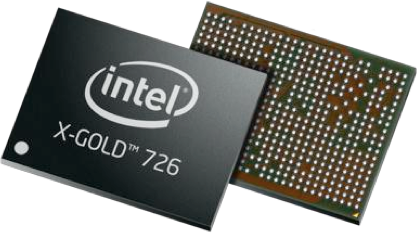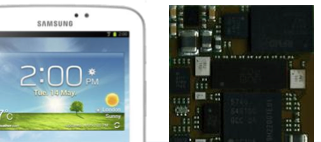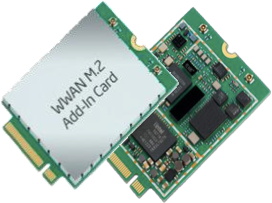Intel Reveals XMM 7260, XMM 7160, & M.2 4G LTE Modems
Last year’s XMM 7160 was Intel’s first LTE 4G CAT 4 modem, with 15 bands it covers most of Europe and North America at 150 Mb/s. This year, Intel introduces the XMM 7260 CAT 6 LTE-Advanced modem, supporting 22 bands at 300 Mb/s, all under one global SKU.

Globally, LTE is growing at a phenomenal rate. It’s been predicted by some that the technology will exceed one billion connections, or almost 20 percent of all connections, by 2017. Right now, the United States accounts for half of the LTE connections worldwide, and South Korea is the second-largest at over 30 percent. LTE is expected to expand into every other major market, and Intel intends to to follow its spread. In fact, the company aspires to become the number-two provider of LTE solutions globally. That’s a tall order, but if any company has the logistics to make it happen, it'd be Intel. As a means to facilitate more aggressive growth, we're seeing more products for more markets, and for every price tier.

When Intel started this journey in 2010, it initially purchased the wireless division of Infineon, a chip technology group that produces everything from RAM modules to SoC packages. Before the acquisition, Infineon had contracted SySDSoft (an Egyptian mobile technology start-up) to produce a proprietary Android LTE stack for its MIPS SoC. So, when Intel needed software for its Infineon-developed LTE technology, it only made sense that the company would also acquire SySDSoft, and that happened in Q1 2011. The idea was to get a team of hardware and software engineers together who could hit the ground running, and also produce technology with a forward-looking focus. More recently, Intel acquired Fujitsu Wireless, a small division of the Japanese giant devoted to LTE multimode technology, based in Tempe, Arizona. That last buy-up completes the package, allowing Intel’s latest LTE-Advanced modem, the XMM 7260, to be a completely global device.
4G LTE: XMM 7160 And M.2 Module
First, let’s look at last year’s model and how Intel plans to make it ubiquitous. The 7160 Slim Modem is made of two devices that work in concert: the X-Gold 716 Baseband Processor and the SMARTi 4G transceiver.

The X-Gold 716 supports up to 100 Mb/s for LTE and VoLTE (Voice over LTE) on 4G networks, while 42 Mb/s DC-HSPA and 5.7 Mb/s HSUPA are supported for 3G networks. The SMARTi 4G transceiver supports 15 4G LTE bands, covering most of Europe and North America, with some support for China and South Korea; with Samsung being Intel’s first customer, this is no surprise. 3G support is offered via eight-band HSPA, four-band EDGE, and Multi Slot Class 33 GPRS.

XMM 7160 was first delivered to market in the Galaxy Tab 3 10.1", and shipping an Intel processor in an Android device marked a first for Samsung. While the tablet didn’t turn heads, it did indeed prove that Intel was capable of delivering a solid Android 4G LTE experience. But the company wants to make XMM 7160 more than just one solution. The idea is to make XMM 7160 as ubiquitous as possible by offering support for as many different configurations as needed.

To that end, Intel also offers XMM 7160 in the M.2 PCI Express module, which means it can suit larger devices like transforming tablets, ultrabooks, and laptops. So far, Asus, Dell, Lenovo, and Samsung have adopted the card for Windows-based mobile products. Not exactly an earth-shattering array of partners, but certainly enough to leverage brand awareness.
In order to capture the number-two LTE provider slot, Intel will have to do more than just rely on existing partnerships, so it's also offering an LTE-Advanced package, the XMM 7260.
Stay On the Cutting Edge: Get the Tom's Hardware Newsletter
Get Tom's Hardware's best news and in-depth reviews, straight to your inbox.
XMM 7260: Global 4G LTE-Advanced
On paper, XMM 7260 sounds extremely appealing, as far as OEMs and IHVs go. It’s supposedly the first truly global LTE-Advanced SKU, and that means Intel has a real chance to get a leg up on its competition, and could very well achieve its goal of becoming the world’s second biggest LTE provider.

As with XMM 7160, 7260 also consists of two components: the X-Gold 726 Baseband processor and the SMARTi 45 Front End. This time, however, it’s a much more power-efficient and cost-effective two-chip solution. In terms of LTE-Advanced, it supports up to CAT 6 at 300 Mb/s and Carrier Aggregation up to 40 MHz. Due to the simplified two-chip design, Carrier Aggregation is achieved entirely within one chip. This saves power as less chips need to be engaged at the same time while aggregated LTE segments switch in and out.
The number of bands has more than doubled over the XMM 7160, to over 30. This makes the XMM 7260 a truly global LTE-Advanced solution, having support for every band used in every country that uses LTE. Moreover, up to 22 of these bands can be used simultaneously, meaning that switching between bands should be seamless, which is a key factor for globetrotters. There's no more need for one device per region/provider.
As an LTE-Advanced chipset, XMM 7260 supports LTE FDD/TDD, which is expected for full and proper Carrier Aggregation up to 40 MHz. What’s really interesting is that TD-SCDMA support is also included, so China is now fully supported for 4G LTE as well. This seems key if Intel wants to take that number-two position. Market research shows that China looks set to grow by almost 130% in terms of LTE take-up due to China Mobile’s TD-LTE rollout late last year, and Intel is well aware of this. Right now, TD-SCDMA take up is already over 60% in China, so Intel is smart to offer TD-SCDMA support, something that some Chinese chipset-makers haven’t even fully implemented yet.
Finally, due to the maturity of the chipset and its simpler two-chip design, Intel states that it significantly reduces power consumption by a further 20%. Whether this is in comparison to XMM 7160 or earlier chipsets is unclear.
Leveraging The LTE Market
Intel has made its intentions clear: the company wants that number two LTE chipset manufacturer spot, and it’s playing hardball to get there. The delivery of TD-SCDMA support for China in XMM-7260, along with the entirely global focus makes that clear. But what’s the end game? Surely, it’s to position x86 as a ubiquitous a mobile solution, as it clearly intends XMM 7260 to be. China is a big part of that picture, and it’ll be surprising if Intel doesn’t leverage its capacity for volume discounts.
Check out all our Mobile World Congress 2014 coverage here!
Follow Dorian and Tom’s Hardware on Google+
-
rwinches Wow! Impressive tech. So, by 2015 we will see this offered?Reply
It should be noted that this tech started with smaller more focused firms, however the combination of the tech was all Intel so it does make it good.